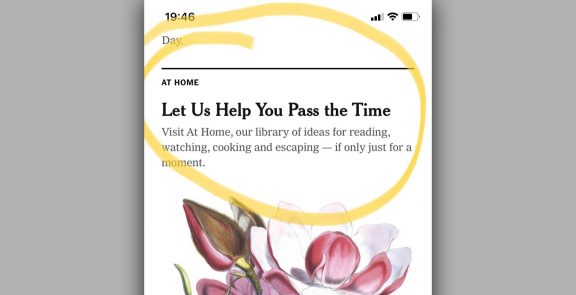

Onlyfans: Need to reconnect with your consumer?
IN A NUTSHELL:
Onlyfans establishes a new relational model with fans, which sheds light on new ideas for thinking about strategy and relevant and contemporary innovation.
THE GREAT STRATEGIC TAKEOUT:
The DTF (direct to fan) model offers new opportunities to rethink brand strategies and connect with the consumer in a new context: consumer centric, personalisation, humanisation of the virtual world, disintermediation and subscription models for paid content.
Why should I read this?
The pandemic and isolation have inevitably contributed to the migration and evolution of the strategy of brands towards the virtual world: occasions, needs, channels, formats, relationship with targets and experiences are transformed. The DTF model emerges as a viable option that can generate equity and profit equally.
What are we talking about?
First of all, let’s find out what Onlyfans is! Onlyfans is a patronage and subscription platform where different creators (artists, celebrities, gamers, DJs, actors, models, influencers and physical trainers, among others, as well as sex workers and porn actors) offer private and exclusive content to their fans in exchange for money.
If we look beyond its obvious image problem (due to the large amount of pornographic content and its niche appearance), we see a platform that has grown exponentially in the last year and that, according to Forbes, “has over 85 million registered users who subscribe to one million content creators”.
The elements of its DTF strategy offer important ideas for the evolution and adaptation of brands, products and companies to the new consumer and reality.
1. From consumer to fan: the true consumer centric model: A different understanding and approach to audiences: it is not about consumers to sell to, but about fans to appeal to. This involves some changes in the relationship:
- On the one hand, the hierarchies between the fan and the creator are dissolved (or if we speak the language of brands, between the audience and the brand), as the fan is completely involved in development, and they are looking forward to collaborating. Creators and fans work hand in hand to decide which content is most attractive. While creators have the power to determine the value of their product, fans have the ability to influence everything. This means the consumer centric model becomes more real than ever.
- On the other hand, the fans receive an experience that is always personalised, based on exclusive content, personal interactions, discounts on promotional items, private events, livestreams, surprises, personalised greetings, the possibility to choose the themes of the content, or even to have their name appear in the content itself.
2. From physical connection to human connection (physical or online): the need for greater closeness, humanization and belonging in the virtual world: This model shows that connecting closely and humanly with the audience is also possible in the virtual world and without leaving the house. When the experience and participation of fans is authentic, relevant content is created for and with this audience, thus consolidating communities with common interests and goals.
3. From physical channel intermediation to online channel disintermediation: Like direct to consumer, this model leaves the intermediaries behind and makes it possible to connect directly with the followers or fans themselves (creating closer networks and allowing for greater outreach to audiences), reduce costs, gather data constantly and create community.
4. From free content to paid subscription: the monetization of the fan: Is the age of free content coming to an end? It looks like it, at least where “quality” content is concerned. What began with the likes of Netflix or Spotify, the subscription model is today moving to the press and it has reached creators and influencers. The fan receives recognition and exclusive content through different membership proposals, which are always very accessible. This model allows upselling and at the same time imposes a watchout: it becomes essential to constantly maintain the value of the content provided.
Links and what to pay attention to:
Onlyfans
Patreon
Cameo
- Proposals for exclusive content or products/services/experiences for fans: exclusive access to content that is not available elsewhere.
- Humanisation of the content: the artist/person/celebrity/brand creates content based on what the audience asks for in constant communication, strengthening a close relationship.
- Privacy: the importance of promoting privacy and intimacy in the conversation and generating trust.
- The power is the creator’s: to create and share without censorship or limits.
- Stripped-down or DIY content and productions: without major budgets or production, the creation of improvised and spontaneous content works.
- Video content: the relevance of video as a key format is growing.
- Educational content: the “educational” component is key to bringing something new to the audience.
WHY YOU SHOULD BE INTERESTED:
As in every era, once again we need to rethink the way we connect and relate to audiences.
What tension does it resolve?
The need for humanisation, proximity, and identification/conversation with a “real person” is becoming more important than ever in a world in which the big authorities are becoming blurred.
From a strategic perspective:
It is necessary to rethink strategies to adapt to the new consumer and their needs/motivations/interests from all touchpoints (occasions, needs, channels, formats, relationship with targets and experiences).
Who might be interested?
All brands. It is interesting to think about how strategies and tactics can be transferred from these models —until now largely linked to content— to products, experiences and services.
Where do I implement it?
In communication, in developing strategies for relationships with the audience, in innovation, in content creation, in the choice of spokespeople/influencers/celebrities and in the migration of business models to online formats and channels.
How do I implement it?
- Supporting the creators on Onlyfans, Patreon and Cameo, among others.
- Applying DTF strategies:
- Putting the individual at the heart of all decisions: constantly listening to the needs behind individuals.
- Collaborating on and co-creating innovation with the consumer always (not in isolation).
- Redefining how to reach the home through new platforms, using online channels to market and sell products.
- Implementing subscription proposals, such as the delivery of customised boxes, special discounts, exclusive products or time saving proposals.
How innovative is it?
The DTF model provides disruptive keys to adapt to the contemporary consumer and learn how to make brands relevant in this context, as well as proposing alternatives to achieve recurring revenue.
Key concepts:
DTF, DTC, personalization, consumer centric, disintermediation
I WANT IT FOR MY COMPANY/BRAND. WHAT DO I NEED TO KNOW?
Who is using it already?
- Beauty Brands: from Billie, the DTC razor brand that communicates messages with different truths and values that really interest its audience, or Glossier, which always takes consumer feedback into account —from shopping habits to web browsing and comments— on several platforms and with constant interaction, to L’Oréal with Perso, the device that allows us to create personalised makeup and creams at home instantly.
- Music and entertainment industry: Weverse, an app and website created by the South Korean entertainment company Big Hit Entertainment, the main function of which is to broadcast and host multimedia content, as well as to facilitate communication between artists and fans, especially in the world of K-Pop.
Things to keep in mind:
- Use and consolidate all available information from all possible sources (research, online shopping, social network comments, website browsing, etc).
- Incorporate capabilities that enable dynamism and agility in responding.
Cómo me hago una idea más clara:
- About «Creators Economy»
- Other patronage platforms: Patreon
- And finally, an interesting piece 😉
How do I share it with my network?
“New alternatives to connect with audiences, to foster community creation and participation at a time when attention and credibility are scarce”.




